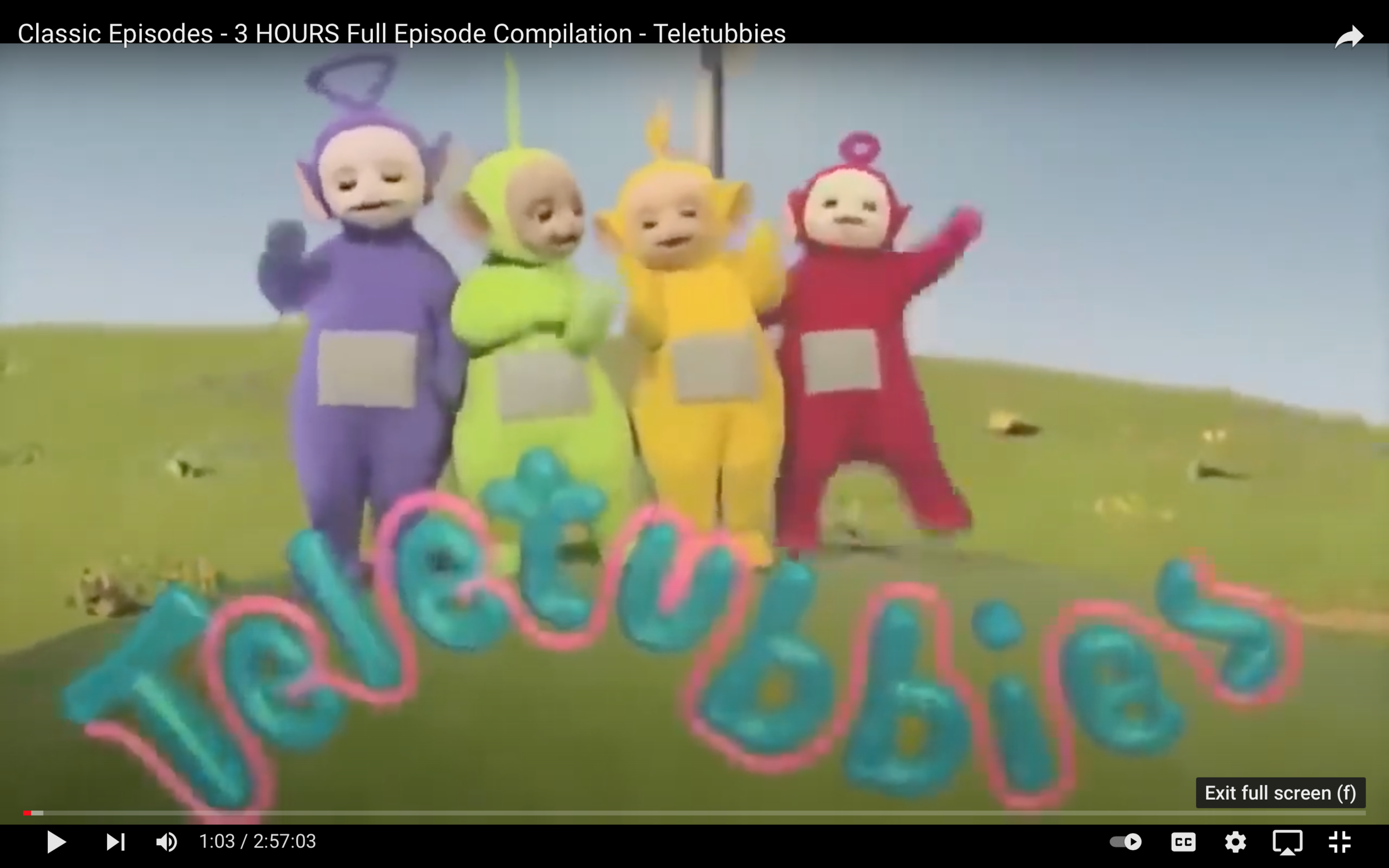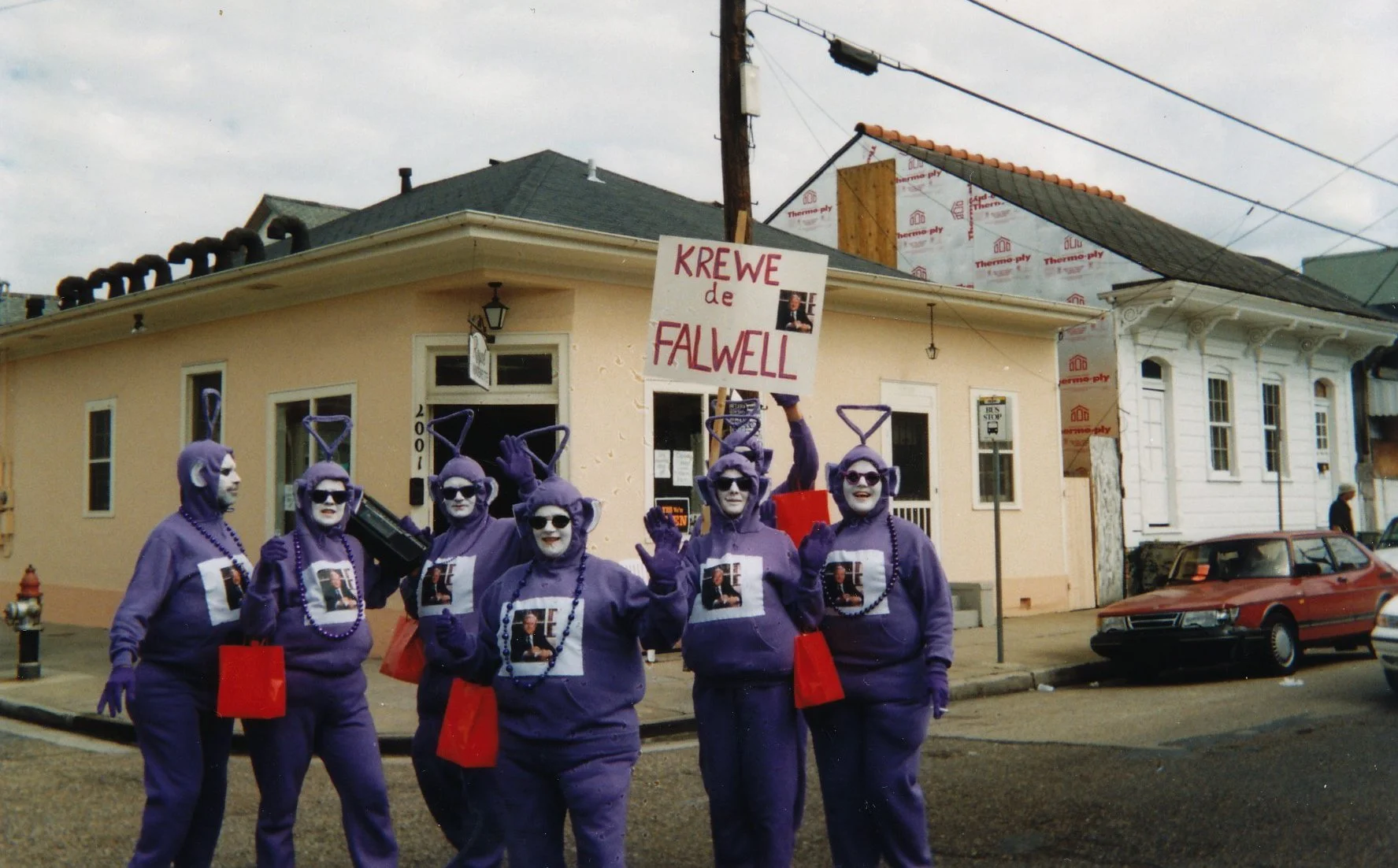Tinky-Winky! Dipsea! Laa-Laa! Po!
The first time my husband and I saw Teletubbies was at the home of our friends who were new parents, and we thought they were nuts!
They had two small children, the oldest one not quite three years old. Most of our peers had children before we did, since we didn’t procreate until my biological clock was a time bomb. So, children’s broadcasting—beyond what we watched as kids and I watched while babysitting in the 1980s and 90s—was unfamiliar territory.
We settled in with our coffee while their children sat rapt on the floor watching these brightly colored, terrycloth humanoid creatures with antennae and TVs for bellies walk around manicured-green hillsides doing a lot of NOTHING.
Back in our car, it was all my husband and I could talk about. How mundane and weird that program was, how we felt we had lost brain cells just watching it, and how we would NEVER ever show that to OUR kids.
Fast-forward to 2006 when we had an almost three-year-old and a one-year-old of our own, toy cars and trains and blocks and stuffed animals all over the living room, and there we were, watching Teletubbies together, laughing out loud and mesmerized. Suddenly, with toddlers and preschoolers in the house, the show made sense.
King Pleasure and The Biscuit Boys performing on Teletubbies
We all grinned as Dipsea chased after Noo-Noo the vacuum cleaner. We sat entranced as Po interacted with bunnies and Tinky-Winky pulled a hat out of his magic red handbag. And we sang along to “The Grand Old Duke of York” (performed by King Pleasure and The Biscuit Boys) during one of the television adventure segments. We sang that for years!
We appreciated that Tinky Winky was non-binary—at least that was our interpretation. The character carried around his purse but had the deepest voice of all the Teletubbies. We were trying to raise our boys without gender stereotyping, a very difficult thing to do in this society. A common phrase in our house when painting or choosing clothes was, “There are no boy colors and girl colors, just colors.” One Christmas, we bought them baby carriages. They proceeded to wheel them around at top speed and smash them into one another. They were broken by the end of January. But that was fine.
When we heard that Jerry Falwell had attacked the Teletubbies show, accusing Tinky Winky of being a covert homosexual figure, we liked the program all the more. Of course, the purple terrycloth character was a wildly popular adult Halloween costume that year.
Costumes for MardiGras in Marigny, 1999 (Wikipedia)
I guess our acceptance, our unexpected enthusiasm for the Teletubbies illustrates how much the center of your universe changes when you have children. The show was not made to entertain adults. It was made for babies whose world at that age consists mostly of their home and perhaps the local park and glances of the world from their parents’ arms. Their view is from the two-foot level and mostly in terms of their own senses. They need reliable routines and they do things over and over, being natural scientists.
I found this plot synopsis of the show online, which sums it up:
The four colorful Teletubbies coo and play in idyllic Teletubbyland. They repeat fun, infant-pleasing activities such as rolling on the ground, laughing, running about, and watching real children on the televisions on their bellies. Mysterious pinwheels and telephones rise out of the meadow to loosely direct the day's activities. The Sun, featuring a baby's face, comments on the proceedings with baby noises, and it rises and sets to begin and end the show.
The original show ran from 1997 to 2001. It was released in March and by August had two-million viewers in the UK. Teletubbies has been aired in over 120 countries in 45 different languages. It aired on PBS Kids, where we watched it, from April 1998 to August 2008. It received a reboot in 2014 to 2018 and is now owned by WildBrain, a billion-dollar children’s entertainment mega-company that has been slowly acquiring all kinds of timeless classics, including The Peanuts, Yo Gabba Gabba and Cailou. The newer version of the Tubbies has that glossed over, brightly animated, fast-paced, generic look of so much children’s broadcasting. WildBrain is traded on the Toronto Stock Exchange, which means their shows no longer belong to children. They belong to investors.
I do like WildBrain’s sense of humor on their website when they talk about the whereabout of the Teletubbies and “Where they are now,” like children actors. It’s in anticipation of yet another reboot in 2022:
Since we last saw the Teletubbies, Tinky Winky relocated to Paris to focus on fashion, Laa-Laa has made a name for herself as a DJ in Ibiza, graffiti artist Dipsy has been enjoying Banksy-esque anonymity and record-breaking artwork sales, and Po has been living a life of enlightenment on a yoga retreat in Thailand.
That sounds about right. Only, this is for parents and has nothing to do with children.
The “new” Teletubbies. Wildbrain.com
Like a Brady Bunch reunion, WildBrain says, “They have now come back together ahead of their 25th anniversary in 2022 to drop a brand-new album and music videos.”
I prefer the original Teletubbies, which had a “home-made” feel to the set representing the inside of their earth dome house. The fuzzy-costumed actors ran around on real grass with real animals on location on a farm in Wimpstone, Warwickshire, England (The site of the dome is now a pond). Now it’s filmed in a studio. The camera shots are shorter, five seconds in length and there is movement in every shot. In the original production, the camera remained on the rising sun with a baby’s face for a full 24 seconds. In the 2014 version, even the background patterns flash and are constantly moving behind the characters. It is frenetic and two-dimensional.
My preference in children’s broadcasting are the simpler and calmer and more real choices, like in Mr. Roger’s Neighborhood and the original Sesame Street. The shots were long, you could see the construction of the sets, and there was a feeling of coming home, of belonging, of familiarity in the design of the productions. It’s what I love about Oakland’s Fairyland too. It’s magical without feeling artificial. It’s not glossed over and flawless like a Photoshopped portrait. It’s approachable.
Children’s television production companies—if not nonprofits—have to stay in business, be profitable. I understand that. I understand the appeal of kids and parents to have stuffed Teletubby dolls and an album of Teletubby dance music and Teletubby placemats and plates and puzzles and whatnot. But something is lost when entertainment for children is monetized. I don’t know. Innocence? A true focus on the children and what is best for them, based on our best understanding of child development and the kids that we know? Love and caring? Individualism? I mean, doesn’t this turn children into consumers? That’s not nurturing.
Our children are now teenagers, and watching the original Teletubbies again to write this, with the baby-faced sun slowly rising on the screen and the characters giggling and running around doing not much of anything, I admit I once again felt my brain melting.
But this wasn’t created for me. Those strange characters are doing things that preschoolers and toddlers like to do, roll around on the ground, run down a hill, dance and fall, learn a new word, hear their own voices, imagine, and be absolutely fascinated with a musical nursery rhyme or a whirling vacuum cleaner. And I like it that way.
The Teletubbies’ main characters. From left to right- Dipsy, Laa-Laa, Po, and Tinky Winky. (PBS)




